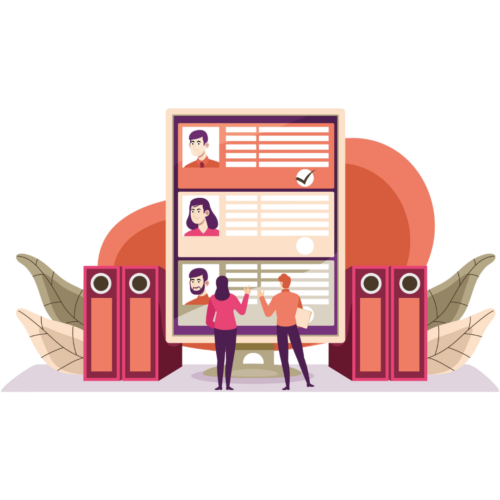
The Hidden Costs of a Bad Hire and How Recruitment Software Can Prevent It
Every recruiter strives to build a dream team—a group of talented, dedicated employees who drive success and innovation. However, when a hiring mistake is made, that dream can quickly turn into a nightmare. A bad hire doesn’t just cause temporary frustration; it can result in significant financial, operational, and cultural repercussions for your company. The true cost of a poor hiring decision often goes far beyond what meets the eye, affecting everything from productivity to company morale.
Luckily, the rise of advanced recruitment software offers a powerful solution to mitigate these risks. In this blog, we’ll delve into the hidden costs of a bad hire and explore how recruitment software is revolutionizing the hiring process to ensure better outcomes.
Understanding the Hidden Costs of a Bad Hire
Hiring mistakes aren’t just inconvenient—they’re expensive. Whether it’s financial loss, team disruption, or a damaged company reputation, the hidden costs of a bad hire can create long-term challenges. Let’s take a closer look at the real impact of bringing the wrong person into your organization.
1. Financial Implications
It’s no secret that hiring is costly, but the true price tag of a bad hire can be staggering. According to the U.S. Department of Labor, a bad hire can cost a business up to 30% of the employee’s first-year earnings. This includes the time spent recruiting, onboarding, training, and managing the underperforming employee, not to mention the potential costs associated with severance packages if the hire doesn’t work out.
But the financial impact doesn’t stop there. You’ll also need to re-invest in the recruitment process to find a replacement, further draining resources. For smaller businesses or departments with tight budgets, this cycle can be devastating.
2. Decreased Productivity
When a new hire doesn’t perform up to expectations, it creates a ripple effect across the organization. A poorly performing employee can slow down entire projects, require additional supervision, and distract the team from their core responsibilities. In fact, research shows that bad hires can reduce overall productivity by 30-50%, leading to missed deadlines and compromised quality.
Moreover, high-performing employees often end up compensating for the bad hire’s mistakes, which can lead to burnout, frustration, and a decline in their own productivity.
3. Cultural Impact
Beyond the financial hit, a bad hire can disrupt the delicate balance of your company culture. Every organization works hard to cultivate a positive, collaborative environment, but when a new hire doesn’t align with the company’s values or work style, the results can be damaging. Miscommunication, friction between team members, and a drop in morale are common side effects of a poor cultural fit.
A strong company culture is crucial for retaining top talent, and a bad hire can quickly undermine the trust and camaraderie you’ve worked to build.
4. Increased Turnover
A bad hire doesn’t just impact their own position—it can cause a domino effect, leading to increased turnover among your existing employees. When team members are forced to compensate for a poor hire, frustration arises, and key talent may seek opportunities elsewhere. According to the Society for Human Resource Management (SHRM), a bad hire can lead to a 17% increase in turnover among high-performing employees.
5. Reputation and Brand Damage
In today’s hyper-connected world, the damage caused by a bad hire can extend beyond the walls of your company. Negative interactions with customers, clients, or partners can harm your reputation and lead to lost business. Additionally, unhappy former employees might leave negative reviews on platforms like Glassdoor, making it harder to attract future talent.

How Recruitment Software Can Prevent Bad Hires
With the significant risks posed by a bad hire, it’s essential to adopt a more strategic approach to recruitment. Recruitment software is an advanced tool that helps businesses make data-driven hiring decisions, streamline processes, and reduce the chances of hiring mistakes.
Here’s how recruitment software can prevent the costly consequences of a bad hire:
1. Data-Driven Hiring Decisions
Traditional hiring methods often rely on gut feelings or subjective impressions, but recruitment software takes a more analytical approach. By leveraging data and predictive analytics, recruitment platforms can evaluate candidates based on a range of factors—such as qualifications, experience, personality traits, and potential for success within the organization. This data-driven approach eliminates bias and ensures you’re hiring based on facts, not just intuition.
In fact, studies show that companies using data-driven recruitment tools experience a 25% improvement in overall hiring success. By making more informed decisions, you can significantly reduce the likelihood of a bad hire.
2. Streamlined Screening with AI
One of the most time-consuming aspects of hiring is sifting through resumes to find the right candidates. Recruitment software uses AI-powered tools to automate this process, screening candidates based on specific criteria and qualifications. These tools can identify key skills, relevant experience, and even personality traits that match your company’s needs.
AI-driven recruitment software also helps to reduce unconscious bias, ensuring that every candidate is evaluated fairly and consistently. With AI, you can focus on the most qualified candidates without worrying about letting a poor fit slip through the cracks.
3. Cultural Fit Assessments
A candidate’s qualifications are only one part of the equation. Hiring someone who aligns with your company culture is just as important. Recruitment software now offers tools that assess cultural fit by analyzing a candidate’s values, work style, and personality. These assessments help you measure whether a candidate will thrive within your team and contribute to a positive work environment.
Ensuring a strong cultural fit reduces the risk of interpersonal conflicts and helps maintain the cohesive, collaborative environment your organization needs to succeed.
4. Structured Interviewing for Consistency
One of the most effective ways to prevent a bad hire is to adopt a structured interviewing process. Recruitment software can guide you through creating and implementing structured interviews, ensuring that each candidate is evaluated based on the same set of criteria. This not only improves consistency but also reduces bias, leading to more accurate and fair hiring decisions.
According to Harvard Business Review, structured interviews are up to twice as effective as unstructured ones in predicting job performance. By standardizing your interview process, recruitment software helps you avoid the guesswork that often leads to hiring mistakes.
5. Learning from Past Hiring Decisions
The best recruitment software platforms don’t just help with the current hiring cycle—they learn from your past decisions to improve future outcomes. Advanced software uses machine learning to analyze previous hires, identifying patterns and insights that can inform your next recruitment strategy. By understanding what has worked (and what hasn’t), you can continually refine your hiring process and reduce the chances of repeating mistakes.

Latest Recruitment Trends in 2024 & 2025
As recruitment software evolves, new trends are shaping the way companies hire. Here are some of the most important trends to watch for in 2024 & 2025:
AI and Machine Learning: AI continues to play a pivotal role in recruitment, from automating resume screening to predicting future job performance based on historical data. The integration of machine learning allows recruitment software to get smarter with each hire, helping companies make better decisions over time.
Mobile-First Recruitment: With an increasing number of candidates using mobile devices to search for jobs, recruitment software is becoming more mobile-friendly. Mobile-first platforms streamline the application process, allowing candidates to apply and communicate on the go.
Diversity and Inclusion Tools: Modern recruitment software includes features that promote diversity and inclusion by minimizing unconscious bias in the hiring process. Blind recruitment features and diversity metrics help ensure a fair and equitable process for all candidates.
Bottom Line
The consequences of bad hire are far-reaching, from financial losses to decreased productivity and cultural disruption. However, by adopting advanced recruitment software, companies can significantly reduce the risk of hiring mistakes and create a more efficient, data-driven hiring process.
Recruitment software empowers organizations to make smarter decisions based on data, streamline their recruitment efforts, and ensure that every hire is the right fit. In today’s competitive talent market, leveraging technology is no longer a luxury—it’s a necessity. By using recruitment software, you can protect your business from the hidden costs of a bad hire and build a stronger, more successful team.
To receive and stay updated about related content:





